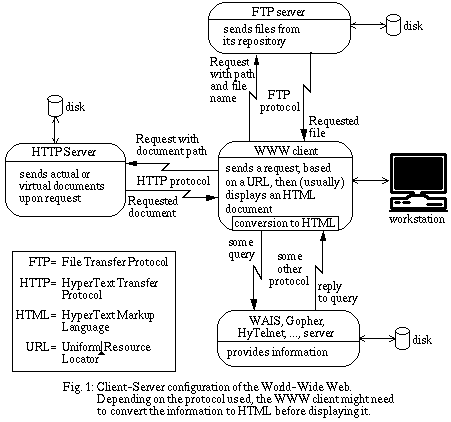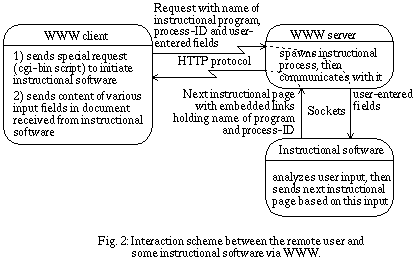Distance learning with the World-Wide Web
Bertrand Ibrahim
<bertrand@cui.unige.ch>
University of Geneva
24, rue du Général Dufour
CH-1211 Geneva, Switzerland
This paper appeared in the proceedings of the International Conference on
"Open and Distance Learning - Critical success Factors", Geneva, 10-12 October,
1994, published by FIM,Erlangen, pp 123-126, ISBN 3-8229-9930-X.
A Postscript version of this document is
available
Summary:
The "World-Wide Web" (WWW) is often seen as just a
means to navigate through hyperdocuments across the
Internet. More sophisticated uses are however possible. The
statistics on the use of the Internet backbone show that the
use of WWW is growing exponentially and is becoming one
of the most important media for global information sharing.
In this paper, we describe the main features of WWW, then
discuss some reasons for its success, and finally, we analyze
those features that should prove most interesting for
distance learning.
Conference theme: Dissemination of Information
Learning Sector: Higher Education
Keywords: Access, Distance Learning, Hypertext/
Hypermedia, Tele-Teaching.
What is the World-Wide Web?
Even though WWW is often referred to by the name of its
most widespread viewer, that is "Mosaic", it can be best
characterized as the combination of a client-server protocol
(the HyperText Transfer Protocol - HTTP) and a markup
language (the HyperText Markup Language - HTML). The
protocol specifies how programs at the two ends of a
communication line (a client and a server) should
communicate with each other, and the markup language
specifies the set of display primitives that a (client) viewer
should be able to handle (see fig 1).

The most common configuration is for an information
provider to run one of the public domain HTTP servers
available for all sorts of platforms, and for an information
consumer to run one of the public domain HTML viewers,
among which Mosaic is probably the most well known
because of its multimedia features.
The most important features of WWW are:
- The integration of most widespread Internet protocols,
allowing the user to have access to almost all existing
resources available on the Internet in an integrated
fashion.
- A uniform naming scheme for Internet resources, the
URLs (Uniform Resource Locators), consisting of various
fields: protocol_name://
Internet_address_of_server_host/path where "path"
is either the full path of a document in the server storage
space, or a query to a database server, or some information
allowing the server to locate unambiguously a resource it
has access to.
- Easy interfacing with external viewers. The documents
are indeed typed and different viewing programs can be
associated to the various types (the most common scheme
is to infer the type of the document from the suffix of the
file name). New types can even be defined, with
appropriate viewers if necessary. When the user follows a
link that points to a document which requires an external
viewer, the WWW viewer (for instance Mosaic) retrieves
that document and launches the corresponding viewer to
handle it. The advantage of this approach is that it is very
easily extendible, but its drawback is that those documents
that require an external viewer are outside the
hyperstructure, that is, they cannot hold links to other
documents.
- Handling of hypermedia documents, since the HTML
language allows for the integration, in a single document,
of text, pictures and icons, which can all bear links to other
documents via embedded URL references. There are some
limitations, though, as video animations and sounds are
handled by external viewers. There is thus no
synchronization possible between an HTML document
and video animations or sounds.
- High portability, since HTML documents are in a simple
and machine-independent format. Each HTML viewer can
display the documents according to its capabilities and
those of the machine it is running on. However, there is
presently very little portability when it comes to video
animation or sound, as very different formats are used in
the various computers available on the market. Platform
independent standards are starting to emerge, like the
MPEG format for video animations, for instance, but they
often involve some limitation, like requiring a color
display.
Why is WWW so successful?
It is always very delicate and error-prone to try to explain
social phenomena. The growth of the Internet usage via
WWW has increased exponentially since its availability,
less than two years ago. This extraordinary growth can
probably be explained by a combination of multiple factors
[1]:
- The Internet growth itself. More than two million hosts are
connected to it, representing an estimate of more than
twenty million users. It has probably reached a critical
mass in which almost anybody can find something of
interest.
- The transparent access to all commonly available Internet
resources, giving access to a gigantic universe of
electronic information, with the added appeal of
hypermedia, making it trivial for anybody to do "net-
surfing". The ease of use is certainly a very important
factor for widespread acceptance.
- The availability, in the public domain, of both server and
viewer software on multiple platforms. The ease of
installation of the server software is probably a key factor
to the increasing amount of documents available all over
the world.
- The relative simplicity of the HTML syntax. Thanks to
this simplicity, information providers do not need
sophisticated tools to prepare their documents.
Distance learning with WWW
Tools such as WWW have mostly been developed to make
it easier to share information among scientists. Even though
they are still in their infancy, these tools are already being
used for distance learning, using the Internet infrastructure
to transport almost transparently information from the
tutors to the learners.
These pedagogical uses have, on one hand, limitations in
what they can attempt to do, compared to educational
software that runs on stand-alone machines, because of the
current limitations of the HTTP protocol and of the HTML
syntax. For instance, current educational material available
through WWW makes only use of the hypertextual
capabilities of the medium, allowing the learner to navigate
through documents without much feedback from the system
[3][4]. But, on the other hand, pedagogical uses of WWW
give the unique opportunity to use the ocean of information
and knowledge that is accessible on the Internet, and that is
now available at a fingertip.
More sophisticated uses of the WWW are possible, without
much additional effort, to provide much more intelligent
tutoring. We have demonstrated, with an actual example
[2], how educational programs can be executed remotely
through WWW, thus making use of all the interesting
features of this tool, i.e. hypermedia and remote access,
without giving up on those features that make tutorials
"intelligent", i.e. maintain a profile of the user and adapt the
behavior of the program to the abilities of the learner.
The basic principle for this sophisticated use is the
following (fig 2): some links can cause a WWW server to
execute, on the server machine, a program or a shell script
which, in turn, can spawn a process that will handle the
pedagogical interactions with the distant user. This "child"
process will run during the whole instructional session and
its output will be sent to the learner's viewer as virtual
HTML documents. These virtual documents contain
embedded links that include the process-ID of the
educational program. They can also contain fields that have
to be filled by the user and that will be transmitted back to
the instructional program by the WWW client viewer.
These virtual documents can, as well, contain links to actual
documents anywhere on the Internet, thus giving the learner
potential (guided) access to this whole world of
information.

References:
- Bruce R. Schatz, Joseph B. Hardin;
"NCSA Mosaic and the World Wide Web: Global
Hypermedia Protocols for the Internet";
Science magazine, Vol. 265, 12 August 1994, pp 895-901.
- Bertrand Ibrahim;
"World-Wide Algorithm Animation";
Advance Proceedings of the First World-Wide-Web
conference, Geneva, Switzerland, May 25-27, 1994, pp
305-316.
- Marcus Speh, Carter Butts, Colman Reilly, Joseph C. Wang;
"WWW for the Globewide Network Academy";
Advance Proceedings of the First World-Wide-Web
conference, Geneva, Switzerland, May 25-27, 1994, pp
335-346.
- Dimitri A. Dimitroyannis;
"Virtual Classroom: A Case Study";
Advance Proceedings of the First World-Wide-Web
conference, Geneva, Switzerland, May 25-27, 1994, pp
325-329.
If you would like to comment on this paper, you can do so by following
this
link  .
.
 Bertrand Ibrahim
Bertrand Ibrahim




Site Hosting: Bronco



 .
.
 Bertrand Ibrahim
Bertrand Ibrahim



